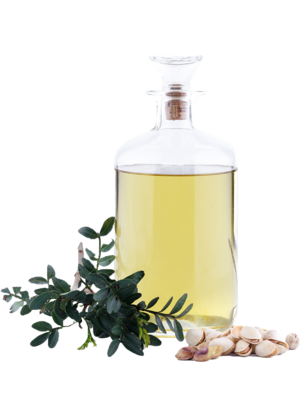Our Pistachio nut oil qualities
We carry Pistachio nut oil in the following qualities for you
Usage
|
Cosmetics |
Food |
Pharmaceutics |
|
|---|---|---|---|
| Pistachio nut oil refined |

Pistachio tree & pistachio fruit
Pistachio oil is obtained from the peeled fruit of the pistachio tree (lat. Pistacia vera). The pistachio tree is also called pistachio and belongs to the sumac family (Anacardiaceae). The pistachio tree can reach an age of up to 300 years as well as growth heights of up to 12 meters. The roots can reach a depth of up to 15 meters. The stalked leaves are pinnate and up to 20 centimeters long. The bark is rough and somewhat reminiscent of oak bark, the branches grow strongly and rather horizontally. The pistachio is dioecious, i.e. male and female flowers grow on different trees. The flowers are inconspicuous and appear in large numbers in clusters that appear in the leaf axes. When the pistachios ripen, the fruit skin dries out, so that they pop sideways and the view is clear to the actual pistachio. This oval to roundish, one to two-centimeter-long kernel is surrounded by a reddish-brown seed skin and is green or yellow in color.
Pistachio trees can bear fruit for centuries, alternating low yielding and so-called fattening years.
Would you like to be informed about the general market situation of Pistachio nut oil and our other products?
subscribe to market reportCultivation & yield
In general, pistachios are grown in North America, the Mediterranean region and in South-West and East Asia.
The main growing areas are California in the San Joaquin Valley, Iran, China and Turkey. Other growing areas are in Greece, Italy and Tunisia.
According to the FAO (Food and Agriculture Organization of the United Nations), the global harvest is just over 1 million tons of pistachios annually.
At harvest time in September or October, the pistachios are nowadays shaken from the plantation trees onto a collecting device with the help of mechanical tree shakers so that they do not fall to the ground.

Background / history
Pistachios originally come from Central Asia, in ancient times they conquered the Mediterranean region. At the end of the 19th century the pistachio was imported to the USA and has been cultivated on a large scale in California since the 1970s. According to a legend the Queen of Saba declared pistachios to be an exclusively royal food and forbid the common people to grow them for personal consumption.
Emperor Vitellius is said to have introduced the pistachio to his capital Rome in the 1st century. At that time the pistachio was used as a dye and home remedy for ailments ranging from toothache to cirrhosis of the liver. Due to its high nutritional value and long shelf life, the pistachio was also indispensable on research trips and for traders.
900
kg
IBC
190
kg
Drum
27
kg
Canister
General durability: canister 12 months, drum 18 months, IBC 6 months
Nutritional values & composition
| Nutritional value | (per 100g) |
| Energy | 3,700 kJ / 900 kcal |
| Fat | 100 g |
| Saturated fatty acids | 13 g |
| Monounsaturated fatty acids | 54 g |
| Polyunsaturated fatty acids | 33 g |
Fatty acids ratio
Composition
| C16:0 Palmitic acid | 8 – 15 % |
| C18:1 Oleic acid | 45 – 58 % |
| C18:2 Linoleic acid | 27 – 37 % |
You want to buy Pistachio nut oil?
Request now free of charge and without obligation from Gustav Heess. We deliver Pistachio nut oil ...
- worldwide
- fast
- reliable
We offer Pistachio nut oil in the following packaging units:
-
900
kg
IBC -
190
kg
Drum -
27
kg
Canister
